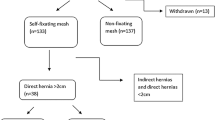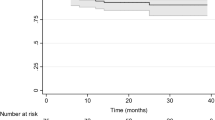Abstract
Purpose
Repair of midline ventral incisional hernias (VIHR) requires mesh reinforcement. Mesh types can be categorised into synthetic, biosynthetic, or biological. There is a lack of evidence to support one type of mesh over another. The aim of this pilot study was to compare mesh sensation in patients having undergone elective open repair with synthetic or biosynthetic mesh.
Methods
Four years of prospectively collected data were retrospectively reviewed on 40 patients who had undergone VIHR, using either biosynthetic or synthetic mesh placed in the retromuscular plane. The decision on type of mesh used was governed by patient characteristics. Patients were invited to complete the Carolinas Comfort Scale (CCS) questionnaire, the higher the score indicating a poorer quality of life. The maximum length of follow-up was 36 months.
Results
Twenty patients received permanent synthetic and 20 biosynthetic mesh. There was no clinical evidence of hernia recurrence in either group in the short to medium term. Overall, 97% (39/40) patients reported an average of either no or mild symptoms (mean CCS score 17.9 of 115). Patients with a biosynthetic repair had a significant lower CCS at ≥ 18 months (p < 0.05).
Conclusion
After VIHR, patients have low CCS scores, indicating good quality of life outcomes, in the short to medium term irrespective of the mesh used. However, biosynthetic mesh had lower CCS scores in the medium term. This may help surgeons and patients make better informed decisions about which mesh to use in their individual circumstances.



Similar content being viewed by others
Data availability
The data that support these findings are available upon request from the corresponding author (Kulkarni G.V).
References
Burger JW, Luijendijk RW, Hop WC, Halm JA, Verdaasdonk EG, Jeekel J (2004) Long-term follow-up of a randomized controlled trial of suture versus mesh repair of incisional hernia. Ann Surg 240(4):578–583. https://doi.org/10.1097/01.sla.0000141193.08524.e7
Löfgren J, Matovu A, Wladis A, Ibingira C, Nordin P, Galiwango E, Forsberg BC (2017) Cost-effectiveness of groin hernia repair from a randomized clinical trial comparing commercial versus low-cost mesh in a low-income country. Br J Surg 104(6):695–703. https://doi.org/10.1002/bjs.10483
Parker MJ, Kim RC, Barrio M, Socas J, Reed LR, Nakeeb A, House MG, Ceppa EP (2021) A novel biosynthetic scaffold mesh reinforcement affords the lowest hernia recurrence in the highest-risk patients. Surg Endosc 35(9):5173–5178. https://doi.org/10.1007/s00464-020-08009-1
Bachman S, Ramshaw B (2008) Prosthetic material in ventral hernia repair: how do I choose? Surg Clin N Am 88(1):101–112. https://doi.org/10.1016/j.suc.2007.11.001
Kamarajah SK, Smart NJ, Daniels IR, Pinkney TD, Harries RL (2021) Bioabsorbable mesh use in midline abdominal wall prophylaxis and repair achieving fascial closure: a cross-sectional review of stage of innovation. Hernia 25(1):3–12. https://doi.org/10.1007/s10029-020-02217-3
Köckerling F, Alam NN, Antoniou SA, Daniels IR, Famiglietti F, Fortelny RH, Heiss MM, Kallinowski F, Kyle-Leinhase I, Mayer F, Miserez M, Montgomery A, Morales-Conde S, Muysoms F, Narang SK, Petter-Puchner A, Reinpold W, Scheuerlein H, Smietanski M, Stechemesser B, Strey C, Woeste G, Smart NJ (2018) What is the evidence for the use of biologic or biosynthetic meshes in abdominal wall reconstruction? Hernia 22(2):249–269. https://doi.org/10.1007/s10029-018-1735-y
Lee TJ, Ulisney KL, Choudhuri AK, Swiger JL, Gibeily GJ (2019) Understanding the patient perspective after ventral hernia repair. Hernia 23(5):995–1001. https://doi.org/10.1007/s10029-019-02015-6
Smith OA, Mierzwinski MF, Chitsabesan P, Chintapatla S (2022) Health-related quality of life in abdominal wall hernia: let’s ask patients what matters to them? Hernia 26(3):795–808. https://doi.org/10.1007/s10029-022-02599-6
Antic A, Kmezic S, Nikolic V, Radenkovic D, Markovic V, Pejovic I, Aleksic L, Loncar Z, Antic S, Kovac J, Markovic-Denic L (2022) Quality of life following two different techniques of an open ventral hernia repair for large hernias: a prospective randomized study. BMC Surg 22(1):99. https://doi.org/10.1186/s12893-022-01551-w
Patel V, Hsu JY, Broach RB, Morris MP, Christopher AN, Nathan SN, Cunning JR, Poulose BK, Fischer JP (2022) Calibration of hernia-specific patient-reported outcome measures. J Surg Res 276:182–188. https://doi.org/10.1016/j.jss.2022.02.021
Krpata DM, Schmotzer BJ, Flocke S, Jin J, Blatnik JA, Ermlich B, Novitsky YW, Rosen MJ (2012) Design and initial implementation of HerQLes: a hernia-related quality-of-life survey to assess abdominal wall function. J Am Coll Surg 215(5):635–642. https://doi.org/10.1016/j.jamcollsurg.2012.06.412
Muysoms F, Campanelli G, Champault GG, DeBeaux AC, Dietz UA, Jeekel J, Klinge U, Köckerling F, Mandala V, Montgomery A, Morales Conde S, Puppe F, Simmermacher RK, Śmietański M, Miserez M (2012) EuraHS: the development of an international online platform for registration and outcome measurement of ventral abdominal wall hernia repair. Hernia 16(3):239–250. https://doi.org/10.1007/s10029-012-0912-7
Heniford BT, Walters AL, Lincourt AE, Novitsky YW, Hope WW, Kercher KW (2008) Comparison of generic versus specific quality-of-life scales for mesh hernia repairs. J Am Coll Surg 206(4):638–644. https://doi.org/10.1016/j.jamcollsurg.2007.11.025
Heniford BT, Lincourt AE, Walters AL, Colavita PD, Belyansky I, Kercher KW, Sing RF, Augenstein VA (2018) Carolinas comfort scale as a measure of hernia repair quality of life: a reappraisal utilizing 3788 international patients. Ann Surg 267(1):171–176. https://doi.org/10.1097/SLA.0000000000002027
Van Rooijen MMJ, Tollens T, Jørgensen LN, de Vries Reilingh TS, Piessen G, Köckerling F, Miserez M, Windsor ACJ, Berrevoet F, Fortelny RH, Dousset B, Woeste G, van Westreenen HL, Gossetti F, Lange JF, Tetteroo GWM, Koch A, Jeekel J (2022) Slowly resorbable biosynthetic mesh: 2-year results in VHWG grade 3 hernia repair. Hernia 26(1):131–138. https://doi.org/10.1007/s10029-021-02453-1
Williams KB, Bradley JF, Wormer BA, Zemlyak AY, Walters AL, Colavita PD et al (2013) Postoperative quality of life after open transinguinal preperitoneal inguinal hernia repair using memory ring or three-dimensional devices. Am Surg 79(8):786–793. https://doi.org/10.1177/000313481307900819
Berger D, Bientzle M (2009) Polyvinylidene fluoride: a suitable mesh material for laparoscopic incisional and parastomal hernia repair! A prospective, observational study with 344 patients. Hernia 13(2):167–172. https://doi.org/10.1007/s10029-008-0435-4
Smith A, Slater K (2022) Outcomes of biosynthetic absorbable mesh use in high risk CDC class I ventral hernia repair: a single surgeon series. Hernia 26(1):97–108. https://doi.org/10.1007/s10029-021-02424-6
Finch D, Mehmood S, Varghese J (2021) Abdominal wall reconstruction using biosynthetic absorbable mesh in high-risk complex ventral hernia. Swiss Med Wkly 151:w20449. https://doi.org/10.4414/smw.2021.20449
Miserez M, Jairam AP, Boersema GSA, Bayon Y, Jeekel J, Lange JF (2019) Resorbable synthetic meshes for abdominal wall defects in preclinical setting: a literature review. J Surg Res 237:67–75. https://doi.org/10.1016/j.jss.2018.11.054
Messa CA 4th, Kozak G, Broach RB, Fischer JP (2019) When the mesh goes away: an analysis of poly-4-hydroxybutyrate mesh for complex hernia repair. Plast Reconstr Surg Glob Open 7(11):e2576. https://doi.org/10.1097/GOX.0000000000002576
Chartier C, ElHawary H, Baradaran A, Vorstenbosch J, Xu L, Efanov JI (2021) Tendon: principles of healing and repair. Semin Plast Surg 35(3):211–215. https://doi.org/10.1055/s-0041-1731632
Burger JW, Lange JF, Halm JA, Kleinrensink GJ, Jeekel H (2005) Incisional hernia: early complication of abdominal surgery. World J Surg 29(12):1608–1613. https://doi.org/10.1007/s00268-005-7929-3
Hammond TM, Huang A, Prosser K, Frye JN, Williams NS (2008) Parastomal hernia prevention using a novel collagen implant: a randomised controlled phase 1 study. Hernia 12(5):475–481. https://doi.org/10.1007/s10029-008-0383-z
Sandø A, Rosen MJ, Heniford BT, Bisgaard T (2020) Long-term patient-reported outcomes and quality of the evidence in ventral hernia mesh repair: a systematic review. Hernia 24(4):695–705. https://doi.org/10.1007/s10029-020-02154-1
Rogmark P, Petersson U, Bringman S, Ezra E, Österberg J, Montgomery A (2016) Quality of life and surgical outcome 1 year after open and laparoscopic incisional hernia repair: PROLOVE: a randomized controlled trial. Ann Surg 263(2):244–250. https://doi.org/10.1097/SLA.0000000000001305
Rogmark P, Petersson U, Bringman S, Eklund A, Ezra E, Sevonius D, Smedberg S, Osterberg J, Montgomery A (2013) Short-term outcomes for open and laparoscopic midline incisional hernia repair: a randomized multicenter controlled trial: the ProLOVE (prospective randomized trial on open versus laparoscopic operation of ventral eventrations) trial. Ann Surg 258(1):37–45. https://doi.org/10.1097/SLA.0b013e31828fe1b2
Acknowledgements
The authors acknowledge the efforts of Dr. Jaspal Rajoo in assisting with the data collection for this study.
Author information
Authors and Affiliations
Corresponding author
Ethics declarations
Conflict of interest
There are no financial or non-financial interests that are directly or indirectly related to the work submitted for publication.
Ethical approval, Human and animal rights, Informed consent
Trust approval was sought prior to study commencement. All patients voluntarily gave informed consent for participation and study was conducted in accordance to principles laid by Declaration of Helsinki (1964). No animals were involved in this study.
Additional information
Publisher's Note
Springer Nature remains neutral with regard to jurisdictional claims in published maps and institutional affiliations.
Supplementary Information
Below is the link to the electronic supplementary material.
Rights and permissions
Springer Nature or its licensor (e.g. a society or other partner) holds exclusive rights to this article under a publishing agreement with the author(s) or other rightsholder(s); author self-archiving of the accepted manuscript version of this article is solely governed by the terms of such publishing agreement and applicable law.
About this article
Cite this article
Kulkarni, G.V., Elliott, Z., Rudd, R. et al. A comparison of patient-reported outcomes in patients undergoing abdominal wall repair with either synthetic or biosynthetic mesh: a pilot study. Hernia (2024). https://doi.org/10.1007/s10029-024-03022-y
Received:
Accepted:
Published:
DOI: https://doi.org/10.1007/s10029-024-03022-y




